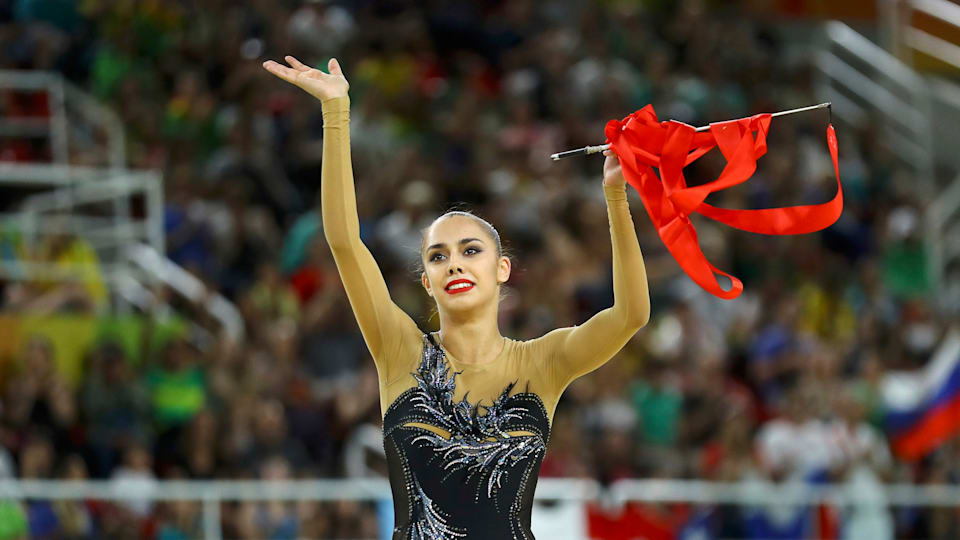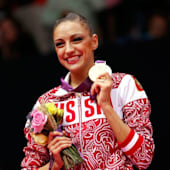
Since rhythmic gymnastics made its Olympic debut at Los Angeles 1984, its athletes have consistently wowed the world with their sublime displays of artistry and beauty set to music.
In 2028, the world will return to Los Angeles to celebrate the Games of the XXXIV Olympiad, which will be a homecoming of sorts for rhythmic gymnastics.
Here we take a look at the sport's Olympic history, and some of the global stars it has produced.
Rhythmic gymnastics before the Olympic Games
Rhythmic gymnastics, which mainly developed in eastern Europe, was first recognised by gymnastics' governing body, FIG, in 1961.
The sport's first World Championships were held in 1963, won by Soviet gymnast Ludmila Savinkova. It slowly gained popularity around the world and by 1973 U.S. rhythmic gymnasts were competing internationally in a sport still dominated by Eastern Europeans.
The discipline had actually previously appeared at the Helsinki 1952 and Melbourne 1956 Olympics as part of women's artistic gymnastics. At both Games, the women's artistic gymnastics teams competed in a "team portable apparatus" competition set to music, with each team choosing one of the five now-recognised rhythmic gymnastics apparatus – ball, clubs, hoop, ribbon, or rope – to perform.
It would finally be added to the Olympic Games programme in its own right in Los Angeles, with the introduction of the Individual All-Around (a Group event would be introduced, again at a Games in the United States, at Atlanta 1996).
To this day, it remains a women's-only sport; for gender balance and equality purposes, the sport's two events make up for the two fewer apparatus in women's artistic gymnastics.
Inaugural event boycott and Barcelona 1992 oddity
Rhythmic gymnastics was accepted onto the Olympic programme by a vote held during the 83rd IOC Session, which was held in Moscow concurrent with the 1980 Olympic Games.
Ironically, its debut four years later in Los Angeles would be affected by the Eastern Bloc boycott; Soviet and Bulgarian gymnasts led the world at the time and the top five from the 1983 World Championships all did not compete at the Pauley Pavilion.
Doina Staiculescu of Romania, who had finished sixth at the 1983 Worlds, was the favourite, but ended up being upset by Canada's Lori Fung, who became the sport's first Olympic champion.
Eastern Bloc gymnasts returned at the next Games in Seoul, where Soviet and Bulgarian gymnasts swept the medals; two Unified Team athletes would also win gold and bronze at Barcelona 1992. That latter Games was also notable for another reason: the competition format used was unlike that used at the previous Olympics or World Championships.
While the top six overall qualifiers took part in the final in Barcelona, it was also decided that the top 12 from each of the four apparatus (which in 1992 excluded the ribbon) would take part in the final, albeit only on the apparatus in which they had qualified in the top 12.
This meant that more than half the field – nine of the 17 finalists – took part on three or fewer apparatus in the final and were out of the medal picture even before they performed in the final. 17th-placed Li Gyong-hui of North Korea scored a total of 27.512 points, nearly 32 points behind champion Alexandra Timoshenko.
The 'Golden Girls' shine in Atlanta
Atlanta 1996 saw the introduction of the Group competition, effectively the sport's team event. The teams from Russia and Bulgaria were the favourites, just as their individual athletes had been in the previous two Games.
Spain, meanwhile, were represented by six girls aged 15 to 17, who had spent the prior two years living and training together (with the exception of Lorena Guréndez, who joined the team just before the Games).
Faced with the daunting task of toppling the Russian and Bulgarian hold over the event, they led after the first stage of the final, then saw neither of their closest rivals manage to overtake them in the second stage.
The team became Spain's youngest Olympic champions, leading them to be called "las Niñas de Oro" – the Golden Girls.
They were featured on the Olympic Channel series Legends Live On, in which team member Nuria Cabanillas admitted they did not understand what their victory symbolised.
She said: "Only today do we realise what we accomplished. The importance of representing your country, that medal and what it represented. Back then we weren’t aware."
Russian and Soviet domination of gold medals
Athletes from representing former Soviet states have won 13 of the 15 gold medals contested in sport's history (10 Russia, 1 Ukraine, 1 Soviet Union, 1 Unified Team) – only las Niñas de Oro in 1996 and inaugural champion Lori Fung (Canada) have come from outside the former Soviet Union.
In addition to Spain's win in the Group competition in 1996, Ukrainian gymnast Kateryna Serebrianskaya took individual all-around gold. The Russians had to settle for individual silver and group bronze that year. However, Russia have won all 10 gold medals on offer since they returned from Atlanta without a gold medal.
Only 13 countries have ever won an Olympic medal in the sport, with athletes from Belarus, Bulgaria, Italy, China, Romania, Greece, and West Germany all having finished on a podium in addition to the countries that have won gold.
Apparatus and event format
Of the five rhythmic gymnastics apparatus, four are used at each Games – all four selected ones in the individual event and three in the group event.
However, the rope has not been used at the Olympic Games since Beijing 2008, with the ball, clubs, hoop, and ribbon being the selected apparatus at both London 2012 and Rio 2016. Indeed, the rope is not currently on the FIG's apparatus program for senior athletes through to 2024, and the last time it was used was in 2017-18 in group competitions.
The individual competition takes place at the Olympic Games as an all-around event, with no separate competitions for each apparatus unlike in artistic gymnastics. Athletes compete on all four apparatus for between 1 minute 15 seconds and 1 minute 30 seconds, and their total score determines the final result.
Group competitions see each team perform two routines, the first with all five athletes using a single apparatus and the second routine with three athletes on one apparatus and two on another. These exercises last from 2 minutes 15 seconds to 2 minutes 30 seconds.
Notable individuals
Lori Fung was the sport's first Olympic champion, making the most of the absence of the Eastern Bloc athletes to shine on the biggest stage. The Vancouver gymnast was 21 by the time Los Angeles 1984 came around – by today's standards, relatively old for a gymnastics champion (Russia's Evgenia Kanaeva became the oldest Olympic champion rhythmic gymnast in 2012 aged 22). She only competed for four more years after the Games before retiring due to injuries and health, eventually becoming a coach.
Spain's Almudena Cid has been to the most Olympic Games in the sport (four), participating at Atlanta 1996, Sydney 2000, Athens 2004, and Beijing 2008. While her Group compatriots won gold at Atlanta, the Basque athlete, who has an element named after her in the ball routine, competed as an individual. She made the final in all four Games in which she competed, finishing ninth in Atlanta and Sydney and eighth at Athens and Beijing.
Evgenia Kanaeva is the sport's only two-time individual Olympic champion, and one of only four people to have won two Olympic rhythmic gymnastics gold medals. (Natalia Lavrova, Yelena Posevina, and Anastasia Bliznyuk were all part of two Olympic champion teams.) Kanaeva has 17 World Championship titles, a record, which includes three all-around crowns.
She was succeeded as Olympic champion by compatriot Margarita Mamun. Speaking recently to the Olympic Channel for Olympic Day, Mamun explained Russia's dominance in the event, which she attributed to the team's head coach and head of the Russian Rhythmic Gymnastics Federation, Irina Viner-Usmanova. Viner has coached the last four women to win individual Olympic gold - Yulia Barsukova, Alina Kabaeva, Kanaeva, and Mamun – and was an Olympic Order recipient in 2015.
"Irina Viner plays a big part in it," Mamun said. "The bar is set so high now, and that is only growing every year.
"We have a lot of girls doing the sport and we have a huge rivalry inside our team. You train on one carpet and next to you is another gymnast who is even better, even stronger. This is how the growth happens - we look at each other and set the level higher every time."







